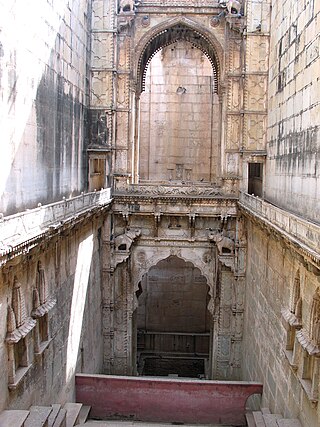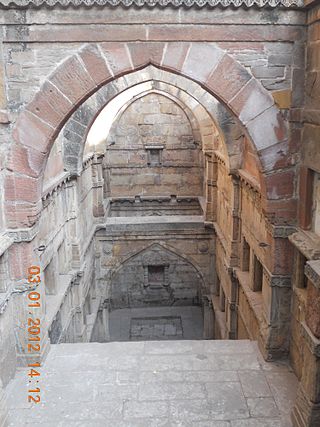
Stepwells are wells, cisterns or ponds with a long corridor of steps that descend to the water level. Stepwells played a significant role in defining subterranean architecture in western India from 7th to 19th century. Some stepwells are multi-storeyed and can be accessed by a Persian wheel which is pulled by a bull to bring water to the first or second floor. They are most common in western India and are also found in the other more arid regions of the Indian subcontinent, extending into Pakistan. The construction of stepwells is mainly utilitarian, though they may include embellishments of architectural significance, and be temple tanks.
Victoria Lautman is an American journalist, writer, and lecturer. She is based in Los Angeles and she focuses on art and culture, including architecture, design, and literature, particularly those of India.

Agrasen Ki Baoli is a 60-meter long and 15-meter wide historical stepwell in New Delhi, India.

Temple tanks are wells or reservoirs built as part of the temple complex near Indian temples. They are called pushkarini, kalyani, kunda, sarovara, tirtha, talab, pukhuri, ambalakkuḷam, etc. in different languages and regions of India. Some tanks are said to cure various diseases and maladies when bathed in. It is possible that these are cultural remnants of structures such as the Great Bath of Mohenjo-daro or Dholavira, which was part of the Indus Valley civilization. Some are stepwells with many steps at the sides.

Rani Ki Vav is a stepwell situated in the town of Patan in Gujarat, India. It is located on the banks of the Saraswati River. Its construction is attributed to Udayamati, the spouse of the 11th-century Chaulukya king Bhima I. Silted over, it was rediscovered in the 1940s and restored in the 1980s by the Archaeological Survey of India. It has been listed as one of the UNESCO World Heritage Sites in India since 2014. This stepwell is designed as an inverted temple highlighting the sanctity of water. It is divided into seven levels of stairs with sculptural panels. These panels have more than 500 principal sculptures and over 1000 minor ones combining religious, secular, and symbolic imagery.

Raniji ki Baori is a noted stepwell situated in Bundi town in Rajasthan state in India. It was built in 1699 by Rani Nathavati Ji Solanki who was the younger queen of the ruling Rao Raja Anirudh Singh of Bundi. It is a 46 meter deep stepped well with some superb carvings on its pillars and a high arched gate. It is a multistorey structure with places of worship on each floor. The step well has a narrow entrance marked by four pillars. Stone elephant statues that face each other stand in the corners. Ogee brackets decorate all the archways of 46 m deep Raniji ki Baori, which is reputedly the largest Baori of Bundi. Baoris were significant social constructions in the medieval Bundi since they acted as assembly areas for the townsfolk. Raniji ki Baori has superb carvings on its pillars and a high arched gate.

Chand Baori is a stepwell situated in the village of Abhaneri in the Indian state of Rajasthan. It extends approximately 30 m (100 ft) into the ground, making it one of the deepest and largest stepwells in India. It is named after a local ruler of Nikumbh dynasty called Raja Chanda and its construction is dated to the 8th-9th century. It has 3500 steps cascading 13 stories deep into a massive tank at the bottom and has been constructed in an upside-down pyramid-style.

Abhaneri, also spelled Abaneri, is a village in the Dausa district of the Indian state of Rajasthan. Abhaneri yields ruins of an ancient city, Abhangari, now popular for the Chand Baori step well and Harshat Mata Temple. It is situated at the Jaipur-Agra Highway. The site was first reported by B L Dhama in 1903 when he prepared List of Objects of Antiquarian Interest in the States of Rajputana. Beside the step well and the temple, it has many sculptures of early Pratihara art of the region. Many of its loose sculptures are housed in display or reserve collections at many museums such as Govt. Museum, Amber. Albert Hall Museum, Jaipur, Hawamahal City Palace, and Archaeological Survey of India. The Indian Government issued a postal stamp depicting the Chand Baori in 2017.

Adalaj Stepwell or Rudabai Stepwell is a stepwell located in the small town of Adalaj, close to Gandhinagar city in the Indian state of Gujarat. It was built in 1498 in the memory of Rana Veer Singh Vaghela cheif
Ambapur Nagla is an H chondrite meteorite that fell to earth on May 27, 1895, in Uttar Pradesh, India.
Badshapur is one of the 4 sub-division of Gurugram district of Haryana state, situated on the Gurugram-Sohna road (NH-248A). It is named after the Badshahpur Fort, which in turn was the abode of the wife of Mughal Emperor Bahadur Shah Zafar. Badshahpur is a part of Badshahpur assembly constituency of Haryana having majority of Rao Sahabs/Ahirs.

Dwarka Baoli is a historical stepwell recently discovered in Dwarka Sub City, in south west New Delhi, India. It was constructed for the residents of Loharehri village by the Sultans of the Lodi Dynasty in the early 16th century. Dwarka now stands where the Loharehri village once stood. Located in a barren stretch of land between a residential society and a private school on Azad Hind Fauj Marg, Sector 12, Dwarka, at 28-35-58.95 degree North and 77-02-38.67 degree East. It was hidden by a large group of Peepal trees and covered by a thick undergrowth which seems to have aided in its relative obscurity. It is mentioned in Maulvi Zafar Hasan's 1910 Monuments list which says it was not very deep and had 22 steps. It is under restoration by the State archeological department and work will be taken up by INTACH Delhi Chapter.

Amritavarshini Vav, also known as Panchkuva Stepwell or Katkhuni Vav, is a stepwell near the Panchkuva Darwaja in Ahmedabad, Gujarat, India.

Bai Harir Sultani Stepwell is a 15th century stepwell in Asarwa area 15 km off Ahmedabad, Gujarat, India.

Jethabhai's Stepwell or Jethabhai ni Vav, is a stepwell in Isanpur area of Ahmedabad, Gujarat, India. It was situated near sha e Alam and one of the heritage stepwells in Ahmedabad.

The Baolis of Mehrauli are four stepwells approached through single stage or three stage steps, located in Mehrauli in Delhi, India, in the Mehrauli Archaeological Park mainlined by the Archaeological Survey of India. These are the Anangtal Baoli, the Gandhak Ki Baoli, and the Rajon Ki Baoli. These were built below the ground level as ground water edifices and were built near shrines in medieval times.
Stepwells are wells in which the water is reached by steps. They are most commonly found in western India especially Gujarat where over 120 such wells are reported. The origin of the stepwell may be traced to reservoirs of the cities of the Indus Valley civilization such as Dholavira and Mohenjo-daro. The stepwells were constructed in the south western region of Gujarat around 600 AD. From there they spread north to Rajasthan and subsequently to north and west India. Construction activities accelerated during the tenth to 13th century during the Chaulukya and Vaghela periods. The construction of these stepwells hit its peak during the 11th to 16th century. The Muslim rulers of the 13th to 16th century did not disrupt the culture that was practiced in these stepwells and encouraged the building of stepwells. The wells lost their significance in the 19th century due to introduction of water pumps and pipe-systems.
Madhavav or Madhav Vav is a stepwell located in Wadhwan town of Surendranagar district, Gujarat, India. It is located in the western side of old town.

The Shahjahan ki baoli, more commonly known as the Choron ki baoli, is a baoli in Maham, Haryana, India. The structure, which was built during the reign of Emperor Shah Jahan, collects and holds rainwater for use by the nearby town of Maham. While no longer in mainstay use, the baoli has been persevered as a tourist attraction.

Brahma Vav is a stepwell in Khedbrahma, Gujarat, India. It was built in 14th century.

















